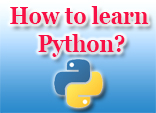Python is a high-level, general purpose programming language that has many common uses now-a-days. It should be learnt by all and sundry on account of its usefulness. It is easy to learn. There are many useful courses that enable you to learn the language.
Python is an often utilized, high-level, general purpose, interpreted, smart programming language. It is object-oriented, imperative, functional, procedural and reflective. From the point of view of design philosophy, it lays great stress on readability. In syntax, the language can be used by programmers to express concepts succinctly in smaller lines of code. Python also proffers constructs aimed at enabling clear programs on both small and big scales.
This language supports many programming paradigms which comprise of object-oriented, imperative and functional programming or procedural styles. It exhibits a dynamic type system, an automatic memory management and a comprehensive standard library. The latest version of Python used is Python 3.5. The language is reputed to be very stable but most industries use the 2.7 version. This is because it is pretty hard to migrate from the older version to the newer. Apart from that, it is easier to learn the Python version v3.x than the v2.x, more potentially, the vs2.7. Most of the material from Python 2.7 have been either entirely denounced or changed to something more novel in the 3.x versions.
The 2.7 is more preferable since it is widely compatible. The 3.x versions will have more far-reaching effects and are thus more useful.
Python is one of the easiest courses to begin with. It was developed by Monty Python many years back. Great releases have been developed by the Open Source Communities, thereafter.
Python training is ubiquitous. Web development apps, socket programming, offline app development are all a result of beneficial use of Python. It is also used to develop Games, apps related to Linux and CGI effects. The best thing about undergoing Python training is that it is very simple and more rudimentary than learning other languages. It is ideal for beginners and obviously the baggage that goes with learning other programming languages is not present here. Python codes need to be indented like those of Ruby.
Before venturing out on the road to learning Python install Python, either v2.x or v.3.x in your system from www.python.org. When installing in Windows take the environmental route while if you are using Linux or Mac, you don't need to go for that sort of a protocol. The latest version of the language is installed by default in both of them. Type in python in the terminal and begin with the default interpreter and the IDLE prompt. Sometimes you reach the old default version of python and while typing in python in the terminal. This is because of the symbolic link. Do not fiddle around with these. Just type in python3.
Python is very portable across different platforms. Apart from that, compiling and converting Python to an executable or Windows or into a dmg or in a shell is very easy. That being the case, you will not even need to convert it into a dmg or a shell file to make it work in Mac or in Linux. There are many other uses of learning Python.
Python course deals with most of the syntaxes, libraries, pointers, function creations, dictionaries, loops, conditions and everything you need to begin making basic apps. Advanced concepts like objects, generators, and error and exception handling are all covered in different types of training courses. Every programmer needs to learn this language. This is because it is helpful even if that programmer does not want to pursue it as a career option.
So, anyone pursuing their graduation or post-graduation in the field of IT, any working professional who wants to develop his or her knowledge base or anyone who wants to learn about programming languages should learn Python.


[ 0 ] Comments